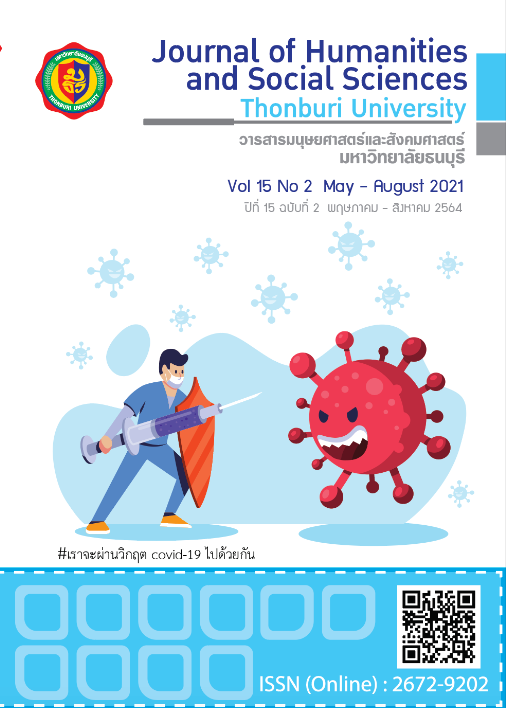Indicators of Super 4Cs Skills for Learners in the 21st Century: A Concise Literature Review
Keywords:
Literature review, Indicators, 4Cs skills, Learners in 21st centuryAbstract
Learning and innovation skills are important for learners in order to achieve purpose of many more complex tasks in their future. This is in line with the Partnership for 21st Century Skills and the National Education Association stipulating that the 4Cs skills consisting of critical thinking and problem solving, creative thinking, communication, and collaboration are essential to sustaining life in the 21st century. Therefore, teaching and learning activities should be elaborated understanding of core subjects and integrate 21st century skills so that the learners have sustained both knowledge and skills to live happily with others in society. In this academic article, the author aims to present the Indicators of 4Cs skills for learners in the 21st century. Relevant literature from various sources including books and related research articles were the subject to study. The meaning of 4Cs skills was summarized and the indicators of those skills were then synthesized. This aims to enable teachers to apply them as the assessment tools to evaluate the learners’ skills and to develop learning activities that promote the essential 21st century skills.
References
กนิษฐา เทาสี, สิรินภา กิจเกื้อกูล, และ มลิวรรณ นาคขุนทด. (2563). การจัดการเรียนรู้โดยใช้ปัญหาเป็นฐานเพื่อพัฒนาทักษะการสื่อสารและทักษะการทำงานกลุ่มของนักเรียนระดับชั้นมัธยมศึกษาปีที่ 4 เรื่องเคมีที่เป็นพื้นฐานของสิ่งมีชีวิต. วารสารศึกษาศาสตร์ มหาวิทยาลัยนเรศวร. 22(2): 31-48.
กระทรวงศึกษาธิการ. (2560). หลักสูตรแกนกลางการศึกษาขั้นพื้นฐาน พุทธศักราช 2551 (ฉบับปรับปรุง พ.ศ. 2560). กรุงเทพฯ: โรงพิมพ์ชุมนุมสหกรณ์การเกษตรแห่งประเทศไทย จำกัด.
กระทรวงศึกษาธิการ. สำนักงานเลขาธิการสภาการศึกษา. (2560). แผนการศึกษาแห่งชาติ พ.ศ. 2560-2579. กรุงเทพฯ: พริกหวานกราฟฟิค.
ทรงยศ สกุลยา และ วนินทร สุภาพ. (2563). การพัฒนาความสามารถในการแก้ปัญหาอย่างสร้างสรรค์เรื่องการประยุกต์สมการเชิงเส้นตัวแปรเดียวด้วยกระบวนการคิดให้เป็นคณิตศาสตร์สำหรับนักเรียนชั้นมัธยมศึกษาปีที่ 1. วารสารศึกษาศาสตร์ มหาวิทยาลัยนเรศวร. 22(4): 88-100.
ทิศนา แขมมณี. (2563) ศาสตร์การสอน: องค์ความรู้เพื่อการจัดกระบวนการเรียนรู้ที่มีประสิทธิภาพ. กรุงเทพฯ: สำนักพิมพ์แห่งจุฬาลงกรณ์มหาวิทยาลัย.
พงศกร วังศิลา, วนินทร สุภาพ, และ จักรกฤษ กลิ่นเอี่ยม. (2563). การศึกษาการใช้แบบจำลองทางคณิตศาสตร์ที่ส่งเสริมความคิดสร้างสรรค์ทางคณิตศาสตร์เรื่องเรขาคณิตวิเคราะห์ของนักเรียนชั้นมัธยมศึกษาปีที่ 4 วารสารศึกษาศาสตร์มหาวิทยาลัยนเรศวร. 22(3): 150-163.
สถาบันส่งเสริมการสอนวิทยาศาสตร์และเทคโนโลยี. (2560). คู่มือการใช้หลักสูตรกลุ่มสาระการเรียนรู้วิทยาศาสตร์ (ฉบับปรับปรุง พ.ศ. 2560) ตามหลักสูตรแกนกลางการศึกษาขั้นพื้นฐาน พุทธศักราช 2551 ระดับประถมศึกษา. สืบค้นเมื่อ 3 กันยายน 2563, จาก https://www.scimath.org/ebook-science/item/8922-2018-10-01-01-54-11.
DeWitt, D., & Alias, N. (2017). Infographic posters for enhancing 21st century communication skills. In World Conference on Education (WCEDU-2017), 12-13 October 2017, Colombo, Sri Lanka.
Ennis, R.H. (1985). A logical basis for measuring critical thinking skill. Educational Leadership. 43(2): 44-48.
Guilford, J.P. (1967). The nature of human intelligence. New York: McGraw-Hill Book Co.
Husniawati, H., Prihandoko, A.C., & Utomo, B.T. (2019). Students’ creative thinking skill on scientific approach based on lesson study for learning community. Journal of Physics: Conference Series. p. 1-13. doi:10.1088/1742-6596/1211/1/012081.
Kembara, M.D., Rozak, R.W.A., & Hadian, V.A. (2018). Research-based lectures to improve students' 4C (communication, collaboration, critical Thinking, and creativity) skills. Advances in Social Science, Education and Humanities Research. 306: 22-26.
Kim, H., & Chae, D.H. (2016). The development and application of a STEAM program based on traditional Korean Culture. Eurasia Journal of Mathematics, Science & Technology Education. 2(7): 1925-1936.
Microsoft Innovative Learning. (2020). 4Cs definition review. Retrieved February 5, 2020, from https://easdinno vativelearning.weebly.com/uploads/7/7/1/6/77162025/4cs_review.pdf.
Ministry of Education. Office of the Education Council. (2017). National education plan 2017–2036. Bangkok: Prickwan Graphic. (in Thai)
National Education Association. (2019). An educator’s guide to the “Four Cs” preparing 21st century students for a global society. Retrieved December 5, 2019, from http://www.nea.org/tools/52217.htm
PBLWorks-Buck Institute for Education. (2020). Collaboration rubric for PBL: (for grades 6-12). Retrieved February 5, 2020, from https://my.pblworks.org/resource/document/6_12_collaboration_rubric _non_ccss.
Ritter, S.M., Gu, X., Crijns, M., & Biekens, P. (2020). Fostering students’ creative thinking skills by means of a one-year creativity training program. PLOS ONE. 15(3): 1-18.
Stufflebeam, D.L., & Shinkfield, A.J. (2007). Evaluation theory, models, and applications. City, U.S.A.: Jossey-Bass.
The 21st Century Educational Technology and Learning. (2020). Collaboration: facilitating and assessing the 21st century skills in education. Retrieved February 5, 2020, from https://21centuryedtech.wordpress.com/ 2019/11/08/collaboration-facilitating-and-assessing-the-21st-century-skills-in-education/
The Partnership for 21st Century Skills. (2009). Framework for 21st century learning. Retrieved May 31, 2019, from http://www.battelleforkids.org/networks/p21.
Thuneberg, H.M., Salmi, H.S., & Bogner, F.X. (2018). How creativity, autonomy and visual reasoning contribute to cognitive learning in a STEAM hands-on inquiry-based math module. Thinking Skills and Creativity. 29: 153-160.
Torrance, E.P. (1967). Creative learning and teaching. NewYork: Dood, Mead and Company.
Wandari, G.A., Wijaya, A.F.C., & Agustin, R.R. (2018). The effect of STEAM-based learning on students’ concept mastery and creativity in learning light and optics. Journal of Science Learning. 2(1): 26-32.
Wongdaeng, M., & Hajihama, S. (2018). Perceptions of project-based learning on promoting 21st century skills and learning motivation in a Thai EFL setting. Journal of Studies in the English Language. 3(2): 158-190.
Translated Thai References
Institute for the Promotion of Teaching Science and Technology (2017). Manual for basic science division (revised edition 2017) according to the basic education core curriculum B.E. 2551 for primary students. Retrieved 3 September 2020, from https://www.scimath.org/ebook-science/item/8922-2018-10-01-01-54-11. (in Thai)
Khammani, T. (2020). Teaching techniques: Knowledge for effective learning process. Bangkok: Chulalongkorn University Press. (in Thai)
Ministry of Education. (2017). Basic Education Core Curriculum B.E. 2551 (Revised A.D. 2017). Bangkok: Printing House Agricultural Cooperatives of Thailand Ltd. (in Thai)
Sakunya, S., & Supap, W. (2020). The development of creative problem solving competency on the application of linear equation for on variable topic on mathemating process of 7th grade students. Journal of Education Naresuan University. 22(4): 88-100. (in Thai)
Taosi, K., Kijkuakul, S., & Nakkuntod, M, (2020). The problem-based learning approach to develop grade 10th students’ communication skills and group working skills in the topic of basic chemicals for organisms. Journal of Education Naresuan University. 22(2): 31-48. (in Thai)
Wangsila, P., Supap, W., & Klineam, C. (2020). The study of using mathematical modeling to enhance mathematical creative thinkin in geometric analysis topic for 10th grade students. Journal of Education Naresuan University. 22(3): 150-163. (in Thai)







